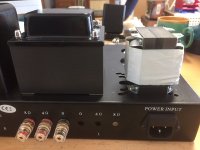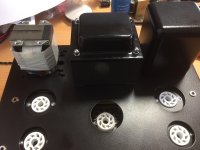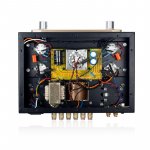Hello to all, In November 2017 I searched the internet to find information about the Boyuu A9 amp. Why especially this amp? Because it came as a kit, case included, in my opinion looked fairly good, would be delivered within 2 days and the price was right. I found the diyaudio forum, became a member, read all threads I found regarding the Boyuu A9 amp (thx to all authors!) and decided to purchase it. If I would have known what would follow.....
Today, after months of trying and testing, with lots of success and disappointment, I'm really happy with the amp. That's why I decided to start this new thread to pass my experiences on to the interested reader. After building the amp the sound was not too bad at all - but there was a hum. Not too loud but noticeable. And that's the main theme of this thread. I really tried a number of things, like:
- increasing the capacity of the power caps - adding a choke / cap in the HT
- replacing the choke with a choke with more inductance
- DC heating (even with external power supplies!)
- wiring / rewiring the heaters (pre- and power tubes...)
- adding grid resistors (that was a good thing!) and many more tips suggested in various numbers of threads, but all with no real success.
I almost gave up, when I got the idea to switch the amp on with all tubes being pulled. The hum was still there! The next step was to completely unsolder the primary coil of one output transformer. I switched the amp on - the hum was still there! Finally I remembered the advice of an old, experienced radio- tv- engineer: check the location / orientation of the components before you start building! This is easy said, but the most critical components (OTs, mains transformer, tube sockets) are pre-installed!
originally mounting of OT:

I unscrewed the OT and moved it slightly away from the mains transformer. I switched the amp on - the hum was still there - but with a lower volume! Now I rotated the OT by 90 degrees - the hum was almost noiseless. Shifting the OT further away from the mains transformer lowered the hum even more! The bad news is that the amp's case is too small to completely get rid of the hum..... I marked the new position, drilled new holes and mounted the OTs (rotated 90°, 12mm shifted from the original position). The result was an almost hum-free amp.....
modified mounting of OT:

But almost isn't perfect..... the last modification (until today) was to elevate the preamp tube's heating. Now the sound is close to perfect to me. If you crawl with your ear into a speaker you'll probably ‘guess' hum - that's fine to me.
I hope some readers / builders find this information useful!
Cheers,
Norbert.
Today, after months of trying and testing, with lots of success and disappointment, I'm really happy with the amp. That's why I decided to start this new thread to pass my experiences on to the interested reader. After building the amp the sound was not too bad at all - but there was a hum. Not too loud but noticeable. And that's the main theme of this thread. I really tried a number of things, like:
- increasing the capacity of the power caps - adding a choke / cap in the HT
- replacing the choke with a choke with more inductance
- DC heating (even with external power supplies!)
- wiring / rewiring the heaters (pre- and power tubes...)
- adding grid resistors (that was a good thing!) and many more tips suggested in various numbers of threads, but all with no real success.
I almost gave up, when I got the idea to switch the amp on with all tubes being pulled. The hum was still there! The next step was to completely unsolder the primary coil of one output transformer. I switched the amp on - the hum was still there! Finally I remembered the advice of an old, experienced radio- tv- engineer: check the location / orientation of the components before you start building! This is easy said, but the most critical components (OTs, mains transformer, tube sockets) are pre-installed!
originally mounting of OT:

I unscrewed the OT and moved it slightly away from the mains transformer. I switched the amp on - the hum was still there - but with a lower volume! Now I rotated the OT by 90 degrees - the hum was almost noiseless. Shifting the OT further away from the mains transformer lowered the hum even more! The bad news is that the amp's case is too small to completely get rid of the hum..... I marked the new position, drilled new holes and mounted the OTs (rotated 90°, 12mm shifted from the original position). The result was an almost hum-free amp.....
modified mounting of OT:

But almost isn't perfect..... the last modification (until today) was to elevate the preamp tube's heating. Now the sound is close to perfect to me. If you crawl with your ear into a speaker you'll probably ‘guess' hum - that's fine to me.
I hope some readers / builders find this information useful!
Cheers,
Norbert.
I unscrewed the OT and moved it slightly away from the mains transformer. I switched the amp on - the hum was still there - but with a lower volume! Now I rotated the OT by 90 degrees - the hum was almost noiseless. Shifting the OT further away from the mains transformer lowered the hum even more! The bad news is that the amp's case is too small to completely get rid of the hum..... I marked the new position, drilled new holes and mounted the OTs (rotated 90°, 12mm shifted from the original position). The result was an almost hum-free amp.....
Cheers,
Norbert.
Good work. There are so many reasons why an amp can hum.
The original Dyna Stereo ST70 amp has the same problem. Pull all tubes, and you still hear hum. The power and output transformers are very close to each other.
No angular orientation can completely fix that, and moving the output transformers to where the EL34s were, and moving the EL34s to to where the output transformers were will not fix it either. The additional problem is the fact that the chassis is magnetic steel. Use a steel chassis, and spread the power supply magnetic emanations to everywhere on the chassis.
Global negative feedback reduces the hum once the tubes are warmed up. But if you modify the amp (take out the negative feedback), you will get more hum.
No angular orientation can completely fix that, and moving the output transformers to where the EL34s were, and moving the EL34s to to where the output transformers were will not fix it either. The additional problem is the fact that the chassis is magnetic steel. Use a steel chassis, and spread the power supply magnetic emanations to everywhere on the chassis.
Global negative feedback reduces the hum once the tubes are warmed up. But if you modify the amp (take out the negative feedback), you will get more hum.
@20to20 and @6A3sUMMER
Thank's for your replies!
To me it's a design fault.
More than 200 kits of this amp were sold by just 1 online shop in Germany!
I'm tempted to contact the seller and describe the problem.
Thank's for your replies!
To me it's a design fault.
More than 200 kits of this amp were sold by just 1 online shop in Germany!
I'm tempted to contact the seller and describe the problem.
Can you please post the link for the purchase? What are your partnering equipment? How do you describe the sound?
The seller actually moved from Germany to Poland.....
The link is EL34 Klasse A Rohrenverstarker Hi-Fi Single-Ended Tube Stereo Amplifier DIY Kit | eBay
I think the sound is ok for this price.
The speakers were a DIY project also.
Have a look: Cyburgs-Viech von Berndt Burghard
The link is EL34 Klasse A Rohrenverstarker Hi-Fi Single-Ended Tube Stereo Amplifier DIY Kit | eBay
I think the sound is ok for this price.
The speakers were a DIY project also.
Have a look: Cyburgs-Viech von Berndt Burghard
Why am I not surprised? No more steel chassis for me. Besides the magnetic problems, they are harder to drill, etc.
When I was faced (forced) to use a steel chassis, at least I stood all transformers and chokes off the chassis with 1/4 inch non-magnetic spacers (it can only help a little bit).
When I was faced (forced) to use a steel chassis, at least I stood all transformers and chokes off the chassis with 1/4 inch non-magnetic spacers (it can only help a little bit).
Last edited:
I am currently in the process of building this amp. I've had the kit for 3 months but got delayed. I also encountered the problem others have had of working solely with a schematic. Along the way I discovered what the chinese symbols are for red,blue, brown and black.
The reason I came here is because I wanted clarification after discovering that the photo I obtained on ebay of the completed amp shows the connections to the rectifier valve made wrongly.
These Chinese kits are always electrically dangerous. For this one they make a point of the vinyl metal covering. Unfortunately that means that several exposed metal connections do not have a path to earth. In particular the mounting posts for the board are all isolated. I also found problems with the mounts for the tranformers and the front panel.
Although this has implacations for electrical safety, which I've addressed, I'm also wondering if it influences hum. For example, what's the point of having a cover sheild on the output transformers if it is not effectively grounded?
Also, have previous builders properly earthed the chassis? This is not as easy as one might think. I found it necessary to sand away much of the coating in the oftening places already mentioned and the main earth point which I chose arbitrarily as one of the bolts for a transformer hood.
I also bi-passed the fuse wiring on the power socket. In the UK this is unnecessary as our plugs are fused.
I'll post here when it's all finished and let you know whether any of this has any effect. Re-orienting the output transformers certainly seems like a lot of hassle.
The reason I came here is because I wanted clarification after discovering that the photo I obtained on ebay of the completed amp shows the connections to the rectifier valve made wrongly.
These Chinese kits are always electrically dangerous. For this one they make a point of the vinyl metal covering. Unfortunately that means that several exposed metal connections do not have a path to earth. In particular the mounting posts for the board are all isolated. I also found problems with the mounts for the tranformers and the front panel.
Although this has implacations for electrical safety, which I've addressed, I'm also wondering if it influences hum. For example, what's the point of having a cover sheild on the output transformers if it is not effectively grounded?
Also, have previous builders properly earthed the chassis? This is not as easy as one might think. I found it necessary to sand away much of the coating in the oftening places already mentioned and the main earth point which I chose arbitrarily as one of the bolts for a transformer hood.
I also bi-passed the fuse wiring on the power socket. In the UK this is unnecessary as our plugs are fused.
I'll post here when it's all finished and let you know whether any of this has any effect. Re-orienting the output transformers certainly seems like a lot of hassle.
Attachments
- Status
- Not open for further replies.
- Home
- Amplifiers
- Tubes / Valves
- One more time: Boyuu A9
